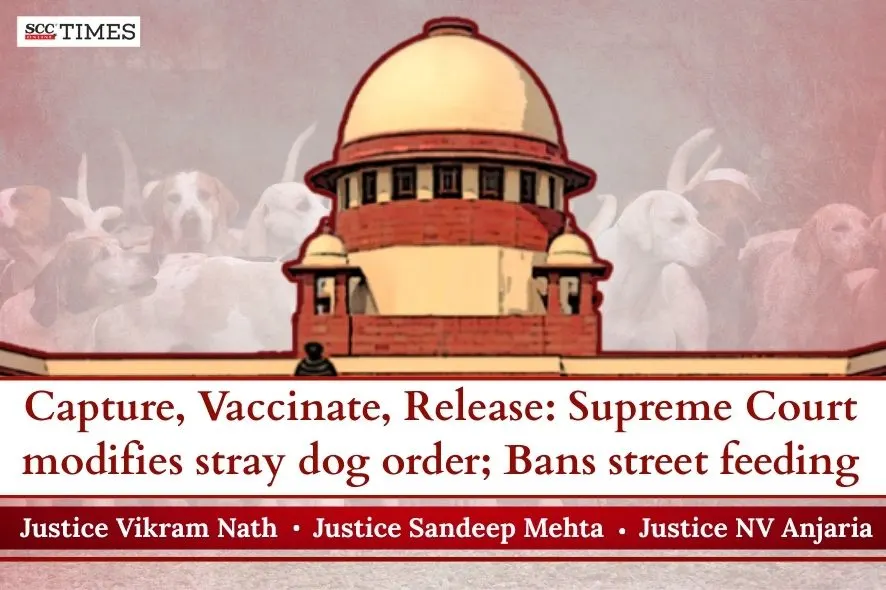Supreme Court: In a suo motu case concerning stray dogs, that was initially heard by a 2-Judge Bench on 11-08-2025, and later placed before a 3-Judge Bench, the bench of Vikram Nath, Sandeep Mehta, and NV Anjaria, JJ modified the directions issued by the 2-judge bench and observed that that “the direction given in the order dated 11-08-2025, prohibiting the release of the treated and vaccinated dogs seems to be too harsh”. The previous Bench, comprising Justice JB Pardiwala and Justice R Mahadevan, had issued directions for the removal of stray dogs in the Delhi National Capital Region (NCR) to shelter homes. The case was then referred to a Three-Judge Bench. The Bench reserved its judgment on 14-08-2025, which was pronounced on 22-08-2025.
The Court noted that, in the intervening period, several interlocutory applications for intervention had been filed, purportedly by individuals and organizations working for the welfare of stray dogs, seeking a stay on the directions contained in the order dated 11-08-2025.
The Court observed that the issue involved in these petitions centered around the right of stray dogs to live on the streets, as opposed to the safety and security of citizens, particularly children and the elderly, from these very stray dogs, many of whom were suspected to be infected with a communicable disease, namely rabies. It was indisputable that human beings bitten by rabid dogs suffered indescribably, and often, the infection proved to be fatal.
The Court also gave a brief description of the issues raised in other petitions apart from the Suo Moto Writ Petition listed before it.
The Court stated, “We make it clear that there is not the slightest doubt in our minds that the intent behind the order is salutary, as it aims to protect citizens at large from attacks by aggressive and rabid stray dogs. However, there are certain vital factors that necessitate a balancing exercise, ensuring that the order dated 11-08-2025 can be carried out to its logical conclusion while keeping its scope within the contours of the legal framework, i.e., the Animal Birth Control Rules (‘ABC Rules’), 2023.”
The Court noted that the two-Judge Bench, in its order, had directed that stray dogs be captured, sterilized, dewormed, and immunized as per the ABC Rules. However, the Bench also stated that “under no circumstances shall the dogs be released back onto the streets.” The order further mandates that all the rounded-up stray dogs shall be kept in shelters/pounds, with no provision for their release.
However, the Court highlighted that Rule 11(19) of the ABC Rules clearly stipulates that once stray dogs are sterilized, inoculated, and dewormed, they must be released back in the same locality from which they were picked up.
The Court said that the directions given in paragraphs 12(iii) and 12(iv) aim to ensure that the same number of stray dogs does not return to the streets after being picked up for sterilization and immunization. Otherwise, this would lead to a continuous cycle, effectively creating a vicious circle.
The Court said that one cannot ignore the fact that the mandate to keep all the stray dogs, picked up from Delhi and the adjoining NCR cities, in municipal shelters/pounds would require logistics of gargantuan proportions. This would include substantial manpower, adequate shelters/pounds, veterinarians, cages, and specially modified vehicles for transporting the captured stray dogs.
The Court noted that the provision in Rule 11(19) of the ABC Rules, 2023, which mandates that dogs, upon sterilization and immunization, be relocated to the same locality from which they were picked up, is scientifically designed to serve two key purposes. First, it helps prevent overcrowding in dog shelters/pounds. Second, it ensures that the sterilized and immunized stray dogs are returned to the environment where they were previously living, which is considered a compassionate approach.
The Court said that aggressive sterilization would undoubtedly curb the rapid growth of the stray dog population, ultimately leading to its reduction. However, this outcome is only achievable in an idealistic scenario, which, in the present context, seems unlikely.
Noting that towns like Dehradun and Lucknow, which have implemented aggressive measures for sterilization, as per the ABC Rules, have seen a steady decline in the stray dog population, the Court said that before any direction for impounding the entire stray dog population was issued, it was essential to assess the existing infrastructure and human resources available with the municipal bodies.
“A blanket direction to capture all stray dogs and place them in shelters/pounds, without evaluating the current infrastructure, may lead to a catch-22 situation, as such directions could become impossible to comply with.”
The Court, therefore, felt that a holistic approach required the mollification of the directions issued in the order dated 11-08-2025. Accordingly, the directions issued by the two-Judge Bench of the Court were supplemented, modified, and clarified in the following terms:
-
Municipal authorities were directed to continue complying with the directions contained in paragraphs 12(i) and 12(ii) of the subject order.
-
The directions contained in paragraphs 12(iii) and 12(iv), to the extent that they prohibited the release of the picked-up strays, were kept in abeyance for the time being. The dogs that were picked up were to be sterilized, dewormed, vaccinated, and released back to the same area from which they had been picked up.
Clarification: This relocation was not to apply to dogs infected with rabies or suspected to be infected with rabies, or those displaying aggressive behavior. Such dogs were to be sterilized and immunized but were not to be released back onto the streets. Additionally, as far as possible, these dogs were to be kept in a separate pound/shelter after sterilization and immunization.
-
The directions contained in para 12(v) remained subject to the directions in paragraphs (a) and (b) above.
-
Municipal authorities were directed to immediately commence an exercise to create dedicated feeding spaces for stray dogs in each municipal ward.
-
The feeding areas were to be identified based on the population and concentration of stray dogs in the ward.
-
Gantries/notice boards were to be placed near these areas, indicating that stray dogs should only be fed there.
-
Feeding stray dogs on the streets was strictly prohibited. Those found feeding dogs in violation of these directions were liable for legal action under the relevant laws.
Clarification: These directions were issued in light of reports regarding untoward incidents caused by unregulated feeding of stray dogs and to mitigate difficulties faced by the public.
-
-
Each municipal authority was directed to create a dedicated helpline number for reporting violations of the above directions. Upon receiving the report, appropriate measures were to be taken against the individuals or NGOs involved.
-
The direction in para 13 of the order dated 11-08-2025 was reiterated with a slight modification:
-
No individual or organization was to obstruct the effective implementation of the directions above.
-
If any public servant was obstructed in the performance of their duties, the violators were liable to prosecution for obstructing a public servant in the discharge of official duties.
-
-
Each individual dog lover and each NGO that had approached the Court was directed to deposit a sum of Rs. 25,000 and Rs. 2,00,000, respectively, with the Registry of the Court within 7 days. Failure to do so would result in disallowing further participation in the matter.
-
The deposited amounts were to be used for the creation of infrastructure and facilities for stray dogs under the respective municipal bodies.
-
-
Animal lovers wishing to adopt street dogs were free to apply to the municipal body concerned for adoption.
-
Identified/selected street dogs were to be tagged and adopted by the applicant(s).
-
It was the responsibility of the applicant(s) to ensure that the adopted dogs did not return to the streets.
-
-
Municipal authorities were directed to file an affidavit of compliance, providing complete statistics of the resources available, such as dog pounds, veterinarians, dog-catching personnel, and specially modified vehicles/cages for compliance with the ABC Rules as of the present date.
The Court noted that since the application of the ABC Rules, 2023 was uniform across the country, and the issues raised in the Suo Moto Writ Petition were likely to arise or had already cropped up in every State, it proposed to expand the scope of the matter beyond the confines of New Delhi and the NCR region.
To this end, the Court directed the impleadment of all States and Union Territories in the matter through the Secretaries concerned with the Animal Husbandry Department, the Secretaries of local bodies (Municipal Corporations, Municipal Councils, Municipalities, etc.), and the Administrators of the Union Territories. This was done to gather information from each authority regarding the steps being taken for compliance with the ABC Rules in their respective jurisdictions.
The Court was informed that numerous writ petitions and suo moto petitions were pending in various High Courts, which dealt with similar issues. As a result, the Registry was directed to seek information about such pending writ petitions from the Registrar Generals of all the High Courts. These petitions were to be transferred to the Court for analogous consideration, along with the main matter.
Finally, the Court ordered that the matters be listed after eight weeks for further directions and for receiving the compliance report.
Also read:
The Stray Dog Case Explained: Key Developments and Updates
Amid ongoing Stray Dogs debate, Government outlines strategy to manage Stray Dogs and Rabies
[City Hounded by Strays, Kids Pay Price, In Re, 2025 SCC OnLine SC 1792, decided on 22-08-2025]



